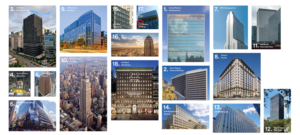
These same skyscrapers also have a fundamental role in achieving our City and State’s climate action goals. This survey provides a diverse set of relevant deep energy retrofit case studies, from around the globe, which demonstrate how high-rise office buildings can achieve low carbon emission targets.
With the passage of the Climate Mobilization Act’s Local Law 97 in April, 2019, the City’s groundbreaking legislation to curb carbon emissions, many questions have arisen about the ability to transform New York’s existing skyline into high performing buildings with dramatically lower carbon emissions — especially our high-rise office buildings. This research team conducted a global search for deep energy retrofits of high-rise office buildings that achieved LL97’s aggressive carbon emission limits, and asked, what can we learn from them?




